This article has been updated to reflect the newest Monash University smartphone app entries (as of 1/15/24), and also preserves some of the very important information that was removed from prior iterations. Lab testing results from FODMAP Friendly have been added as well.
Cocoa is made from the cacao plant, Theobroma cacao. Football-shaped fruit are filled with flesh covered seeds. These seeds contain the cacao nibs; all cocoa powder and chocolate bars derive from these cacao nibs. This article explores cocoa from a FODMAP perspective.
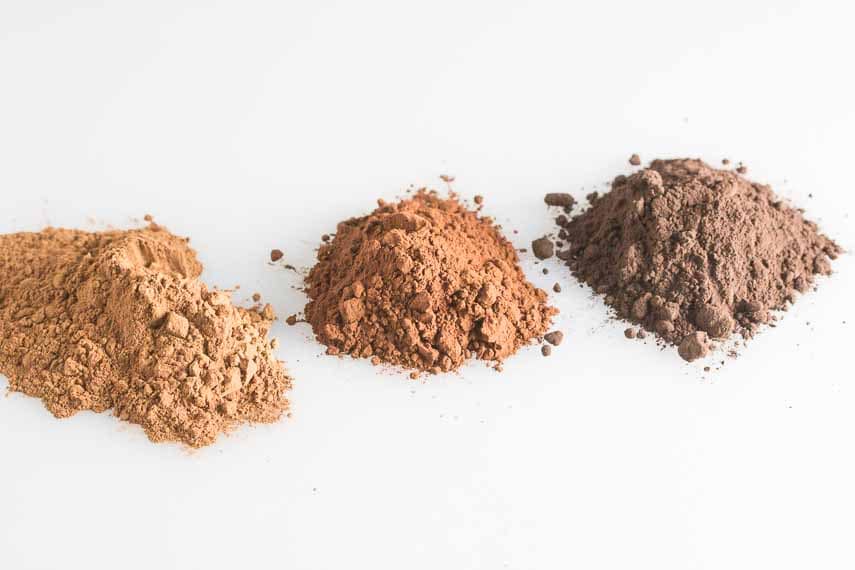
For information on dark chocolate, milk chocolate or white chocolate in relation to FODMAPs, please refer to those articles.
- Cocoa, "Cacao" & FODMAPs
- My Educated Guesses In Regards To The Different Lab Results
- FODMAP Content Of Cocoa Powder
- A Look at Chocolate & Cocoa Production
- How Cocoa Powder Is Made
- Choosing Low FODMAP Cocoa Powder
- Different Cocoas React Differently in Recipes
- Deeper Dive Into Types of Cocoa
- How Do I Know Which Cocoa To Use If It Is Not Clear?
- Fat Content of Cocoa
- Last Word on "Cacao": It’s All About The Branding
- Low FODMAP Recipes Containing Cocoa
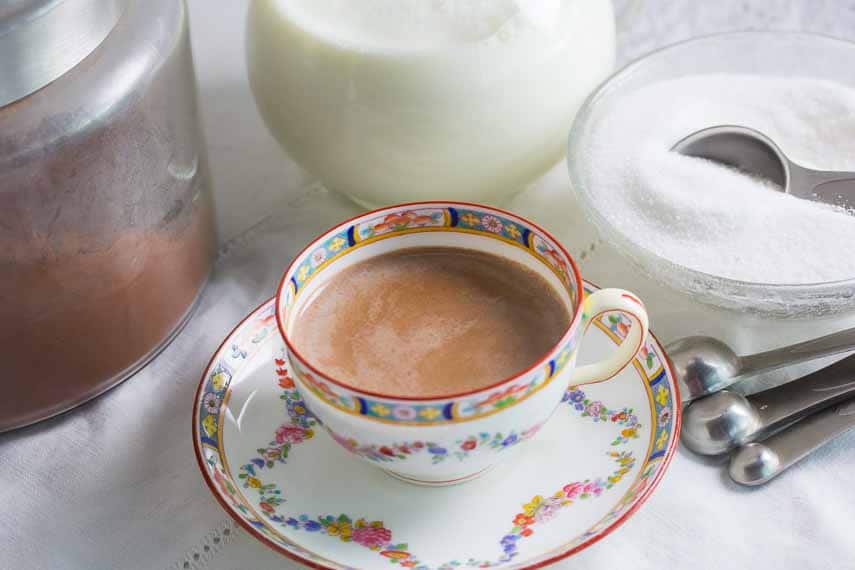
Cocoa, “Cacao” & FODMAPs
First, I would like to address terminology. This article is primarily receiving a major overhaul because of a change that Monash University recently made in their smartphone app. They used to have two separate entries, one for cocoa, and one for cacao powder, and they still do, but before, the lab results for what they presented as two “different” food items, varied widely – with a 10x factor difference, which is significant.
The problem with this is that “cacao” powder is not a recognized term, and we had brought this to Monash’s attention numerous times. They had obviously lab tested different cocoas, but one batch was not “cacao” and the other batch “cocoa”. They were just different cocoas, and they would not provide further information.
From the chocolate manufacturing industry’s perspective, there is no difference between cacao and cocoa powder. The FDA, The Food Standards for Australia and New Zealand, the ICCO (International Cocoa Organization) and the National Confectioners Association do not even recognize the term “cacao” to describe cocoa powder. “Cacao” powder is a marketing term (more on this below).
My Educated Guesses In Regards To The Different Lab Results
My guess is that Monash bought products that were indeed labeled differently, some as “cacao powder” and some as “cocoa powder”. They took the nomenclature at face value, believing these were different products. Not being food people, they did not realize that “cacao” was a marketing term and made no definitive references on what the products were in terms of fat content, carbohydrate content, whether they were natural cocoa, Dutch-processed, etc.
I think there are two main reasons the lab results differed:
- It could be as simple as some of the cocoas tested being higher in fat, the others fairly low. A higher fat product would contain fewer carbohydrates and therefore fewer FODMAPs. Cocoa can range from 10% to about 24% fat; a large range.
- The “cacao” powder tested might have been a “raw” product and the cocoa beans and/or cacao nibs might not have been exposed to as high heat and/or sustained exposure to heat as the other “cocoa” powder product tested. The lack of processing could have affected the FODMAP content, but we do not know.
I proposed these theories to Monash, but they would not provide any further information on what they had tested – and at the time they insisted that cacao and cocoa were different.
I am thrilled that their smartphone app entries for cocoa and cacao now align since there is no difference between these products as far as terminology is concerned. There are of course, different types of cocoa on the market, and we will discuss them in this article. The most common are natural, Dutch-processed, and black cocoa, and there are also various fat and carbohydrate content to cocoas, and since Monash will not tell us what type of cocoas they lab tested, we have to make educated guesses.
As you will see in the following paragraphs, we are preserving some of the information derived from Monash lab testing that they have now removed from their app. We have retained it and share it because it gives those following the low FODMAP diet very valuable information, primarily that cocoa can have a very generous serving size and still remain low FODMAP, which is not what one would take away from the app entries as they stand now.
FODMAP Content Of Cocoa Powder
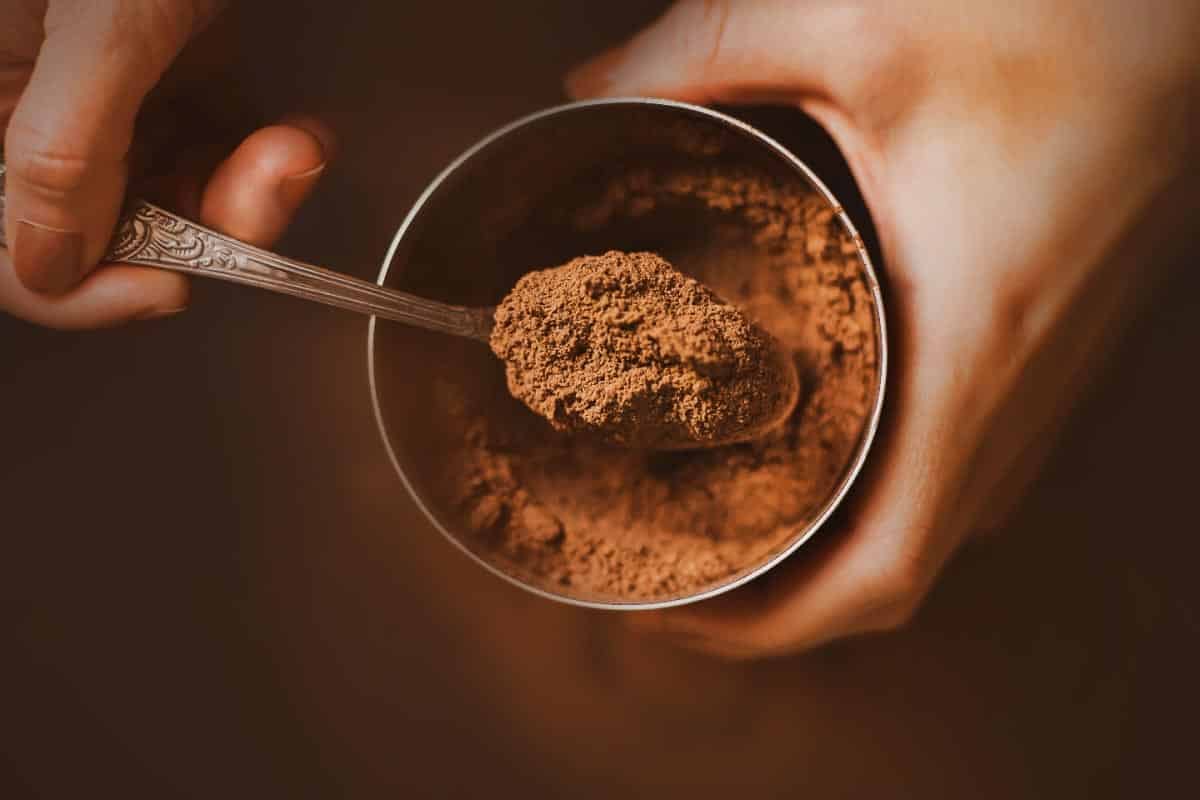
Both Monash University and FODMAP Friendly have lab tested cocoa powder.
Monash University on Cocoa
The current Monash smartphone app entry states that cocoa and cacao (2 separate listings) have Green Light low FODMAP serving sizes of 2 teaspoons (8 g) – and no other FODMAP information is given.
We know from prior statements by Monash that some of the cocoa they lab tested did not reach high FODMAP levels until servings reached over 200 g/7-ounces, at which point both fructans and GOS were detected. This is the information that they have removed from the app, much to our dismay. It helps us understand that cocoa is low FODMAP in much larger portions than 2 teaspoons (8 g).
In lab testing of other cocoas, high FODMAP levels appeared in servings of 20 g/0.7 ounces, at which point both fructans and GOS were detected.
We queried Monash about this discrepancy, as we initially thought perhaps a zero was dropped, or added. They stated that these two very different lab test results were correct.
Since we know there is no difference, other than a marketing difference, between cacao powder and cocoa powder, we believe that there is a great possibility that Monash had one batch that included higher fat/lower carb/lower FODMAP content, and another batch that was lower fat/higher carb/higher FODMAP content. Since cocoas can range in fat from 10% to 24%, this would make sense. If Monash would share what they tested, we could know for sure.
What Monash Cocoa Lab Testing Means
What this means to us as cocoa consumers following the low FODMAP diet, is that cocoa can remain low FODMAP in very generous serving sizes. This also makes sense, since Monash has approved recipes as low FODMAP that have exceeded 2 teaspoon (8g ) per serving.
Finding Cocoa In The Monash App
Finding cocoa in the Monash app can be difficult. It is not listed alongside chocolate (in the Confectionery & Sugars category). You will find cocoa and cacao listed within the Beverages section.
FODMAP Friendly on Cocoa
FODMAP Friendly has lab tested cocoa as well. They have two different app entries.
FODMAP Friendly has lab tested 60% and 70 % cocoa powder BUT the FODMAP concentrations show us that the products tested contain lactose. Seeing that the entire language says, “Powder, drinking chocolate, 60% cocoa”, and “Powder, drinking chocolate, 70% cocoa”, we have to understand that these are hot cocoa drink mixes and not just cocoa powder.
Out of interest, they both have the same low FODMAP serving size of 2 tablespoons (10 g), and the max serve size is 105 g.
The term “cacao” is just a marketing term.
A Look at Chocolate & Cocoa Production
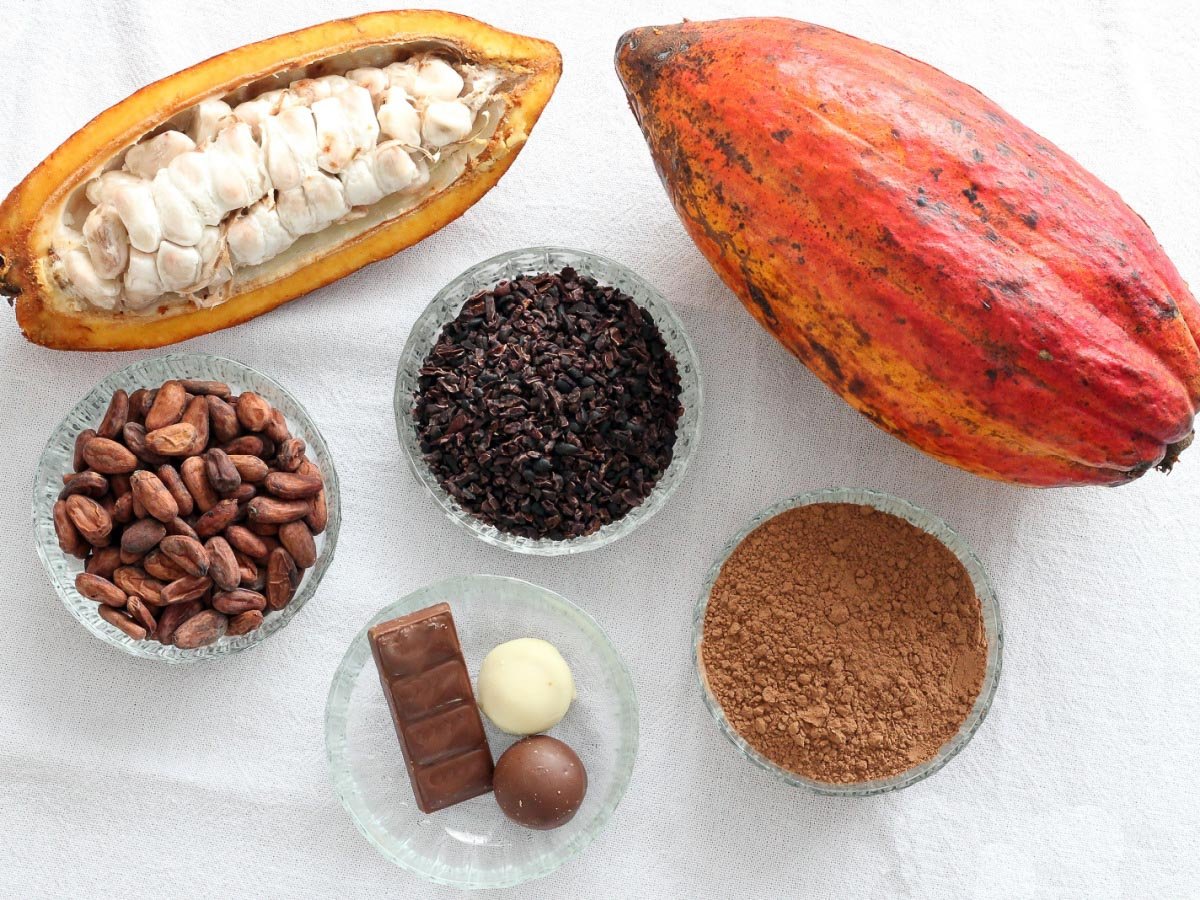
Let’s pause for a moment to look at how cocoa powder are made to understand why the lab tests can show such varied results. You will see that there are many variables during chocolate and cocoa manufacture.
Cacao Pods Are Harvested
Raw cacao pods contain juicy, white, flesh-covered beans. Inside the beans are cacao nibs, from which all chocolate is made – and all cocoa powder, too.
Beans Are Removed from Pods
The beans, covered with flesh, are hand scooped out of the pods upon harvesting.
Beans May or May Not Be Fermented
At this point the beans might be fermented, or not. This step is considered to be an incredibly important part of flavor development by most chocolate manufacturers. During fermentation, bean temperatures reach about 125°F (52°C).
FYI, most raw food proponents say that food should not be heated above 92ºF to 118ºF (33°C to 48°C). BUT there is no oversight, so raw companies can call a product raw and the consumer has no protection or consistency in labeling. The term “raw” is not a reliable term, in this regard.
Cocoa Beans Must Be Dried
The next step for the cocoa beans is drying. The very moist beans are brought down to about 6% to 8% moisture content. This is done by sun drying, or drying can be accelerated with heat. The beans during this process reach temperatures averaging 125°F to 150°F (50°C to 65°C), which again, would put them outside of the “raw” designation.
Raw Cacao? A Meaningless Term
After drying, cocoa beans will be roasted – or not. This is where many “raw” purveyors will claim that they do not roast their beans and therefore their beans are “raw”, but we can see from what happens prior to this that the beans indeed are exposed to temperatures higher than what most raw proponents desire.
Handling Of Cocoa Beans
Once the beans are dried and/or roasted, it is time to make chocolate and/or cocoa powder.
The beans are cracked open (the industry term is “winnowed”) and the inside of the bean, the cacao nibs, are exposed.
ALL chocolate begins with the nibs. ALL cocoa powder begins with nibs. We are focusing on cocoa powder in this article.
How Cocoa Powder Is Made
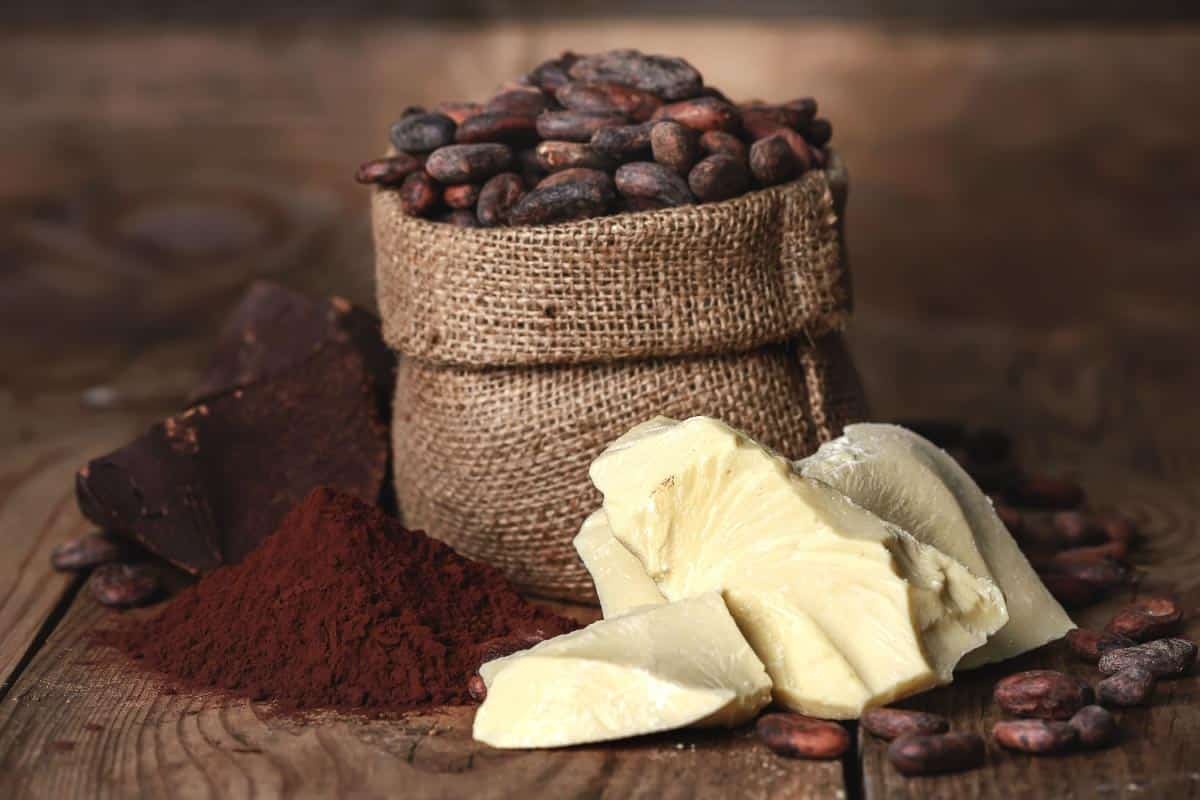
The nibs contain about 50% cocoa butter, which is the natural fat in cocoa beans. If the nibs are exposed to about 6000 psi of pressure, the cocoa butter will melt and can be separated out.
What is left is a dry(ish) mass, which is what becomes cocoa powder.
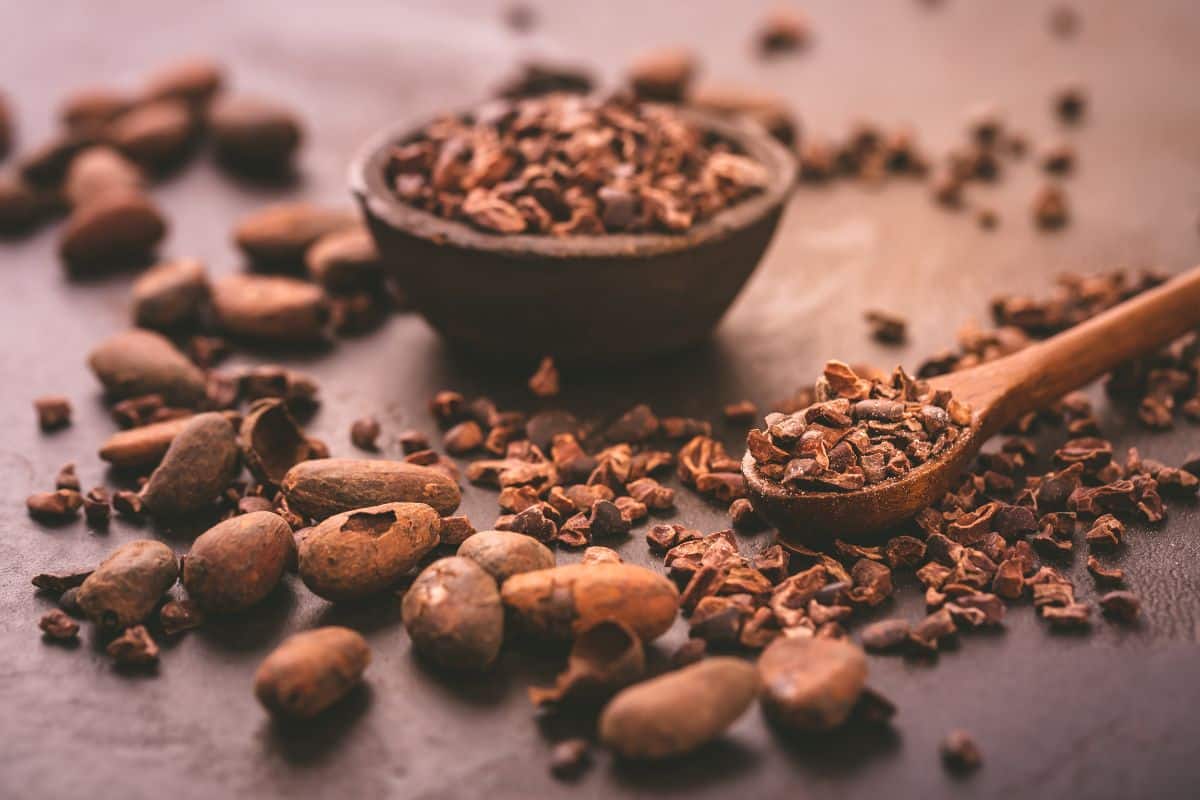
Cocoa powder can range in fat content from about 10% to about 24%. This is a huge variable, and might speak to the differences in lab testing that Monash initially reported.
If we have to make a general statement, we can say that natural cocoas are lower in fat and Dutch-processed cocoas are higher in fat (more on these terms below), but this is a generalization. (Ghirardelli is opposite, as an example). But the point is that some can be as low as 10% fat and others as high as 24%.
Choosing Low FODMAP Cocoa Powder
You probably want to know how to choose a cocoa powder to use while following the low FODMAP diet. Here are my recommendations, which also apply to any baking you might do with cocoa, low FODMAP or not.
- Use the type of cocoa called for in the recipe. If it says natural cocoa, use that. If it says Dutch-processed, use that. There is even “black” cocoa (more below on what these terms mean).
- If a recipe calls for “cacao” all bets are off. Frankly, when I see that term I get suspicious. It is usually from a source that is presenting their “cacao” recipe as healthier, and there is simply no good research supporting such claims.
- Let’s look at what Monash said (in private correspondence) in regard to their listings for “cacao powder” and “cocoa powder”: “Both are low FODMAP – so safe to include on a low FODMAP diet.”

Different Cocoas React Differently in Recipes
Each type of cocoa has its own flavor profile and will react differently in most baked items. In other words, if a cake recipe lists natural cocoa and you use Dutch-Processed – and the cake doesn’t come out well – it isn’t because you can’t bake or that the recipe didn’t work, it is because you substituted one cocoa for another.
Please don’t do this! Recipes, especially baking recipes, are developed very specifically for the ingredients to interact well with one another. In the recipe development business we have what we call “tolerance”. Some recipes have great tolerance, meaning that you can fidget with them and they will still be fine. Others, not so much.
Since you are investing your time and money in high quality ingredients, we recommend that you always follow the specific directions.
Any FODMAP Everyday® recipe that calls for cocoa will specify which kind we want you to use, usually natural cocoa or Dutch-processed. There is also black cocoa, as mentioned above. You might not have heard of it before – but we bet it looks familiar!
Black cocoa is the color of, and has the flavor of, Oreo cookies! It is featured in our Dark Chocolate Waffles (seen above) which, by the way make THE BEST ice cream sandwiches! You can also see it in our Halloween themed Pumpkin Layer Cake with Black Cocoa Frosting, or our Blackout Cake (seen below).
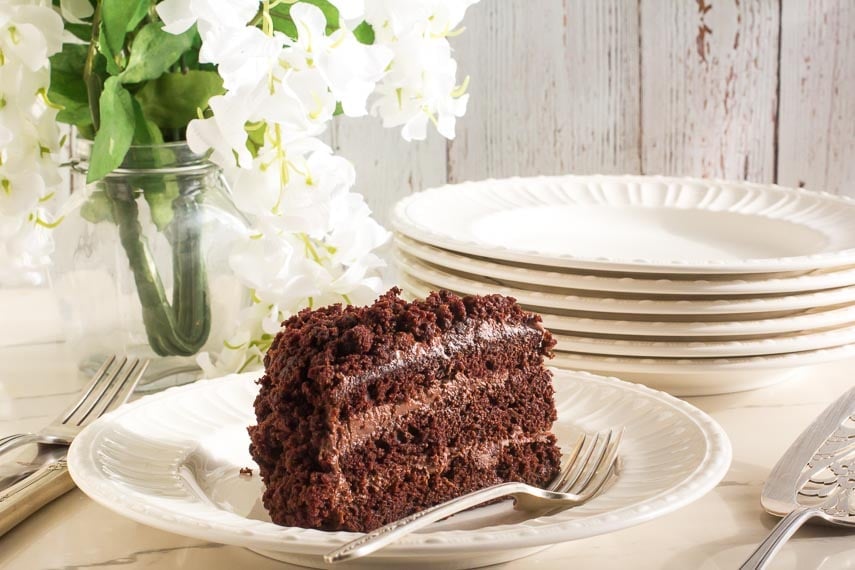
Deeper Dive Into Types of Cocoa
The following sections delve deeper into the differences between natural, Dutch-processed, and black cocoa, which are the ones the US consumer will most often encounter in the stores and in recipes.
Natural Cocoa
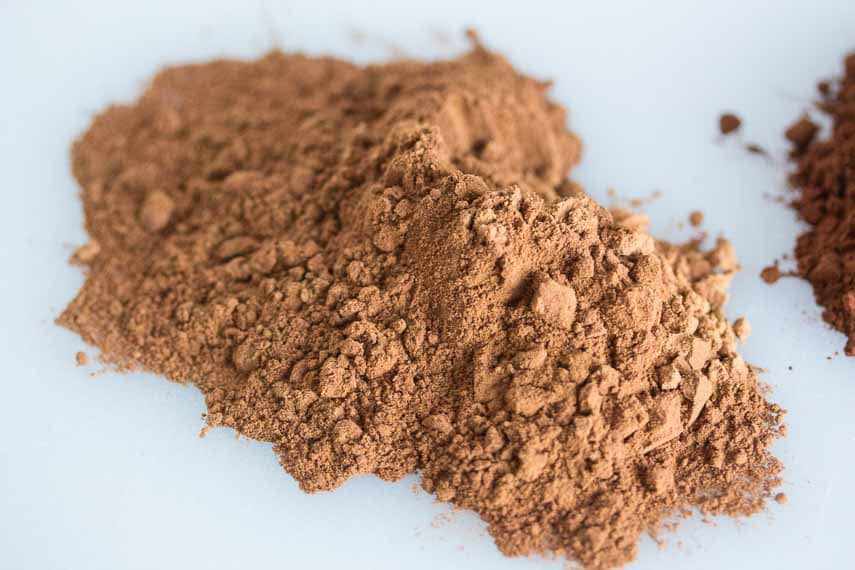
Seen in the top image on the far left, and immediately above, this cocoa will usually be the lightest in color. Looking at labels, natural cocoa might also be called “cocoa powder” or “unsweetened cocoa.” Devil’s food cakes were often made with natural cocoa and in fact they were called “Devil” because of their faintly reddish color. The color is a reaction of the natural cocoa with the baking soda in the recipe.
Natural cocoa has a pH level between 5 and 6, which means that it is a bit acidic. This acidity is tempered in baking recipes by the inclusion of baking soda, with which the cocoa reacts (producing carbon dioxide). Some common U.S. brands of natural cocoa are Hershey’s, Scharffen Berger and Ghirardelli. I also like Penzey’s Natural High Fat Cocoa and also Callebaut Natural Cocoa Powder.
Dutch-Processed Cocoa
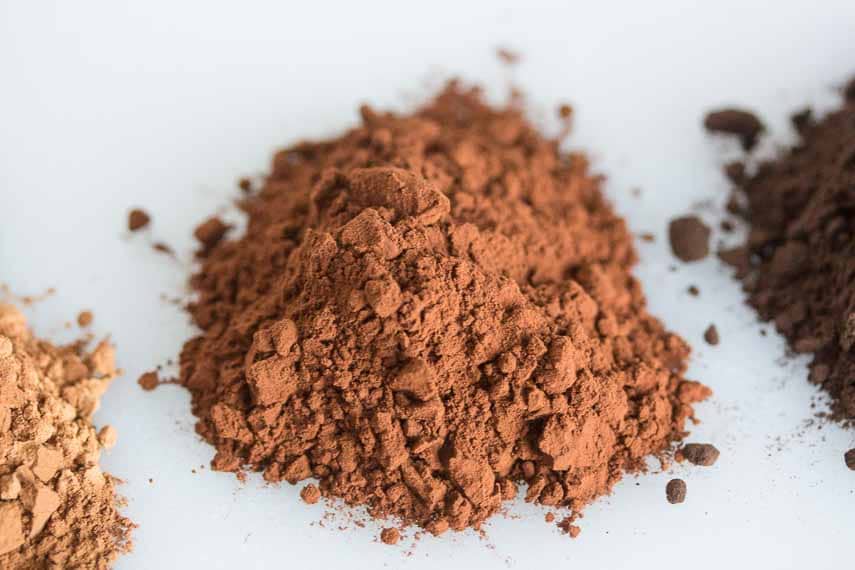
This product (seen in the center of the top image and immediately above) is cocoa that has been processed with an alkalai (usually a potassium carbonate solution) to produce a cocoa that is less acidic. It is occasionally referred to as “Dutched”, “alkalized” or even “European style”.
The color is darker than natural cocoa and the flavor is mellowed and considered smoother, while richer at the same time. The pH is around a 7. Since Dutch-processed cocoa is not as acidic as natural cocoa, recipes calling for Dutch-processed are usually leavened by baking powder. We use Valrhona and Bensdorp in our Test Kitchen.
Black Cocoa
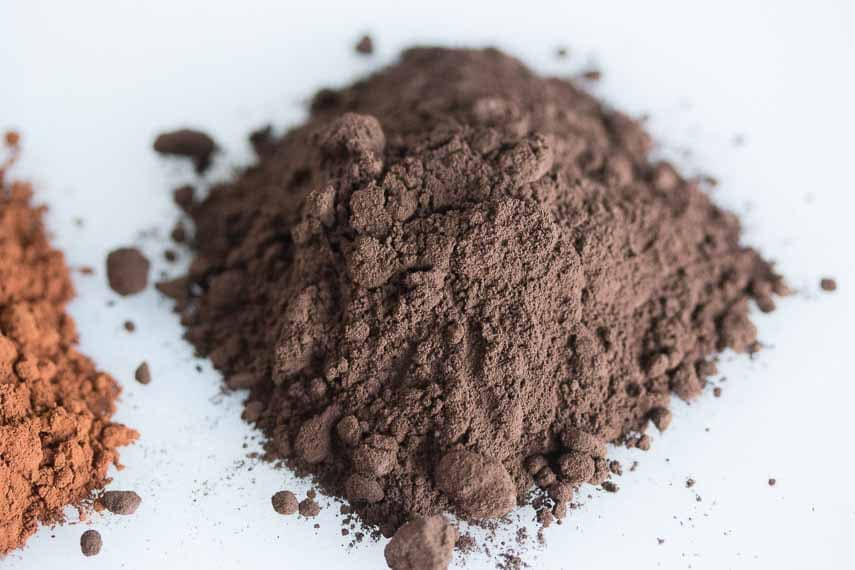
This cocoa is very dark, almost black in color and has a pH of 8. (It is on the far right in the top image and seen immediately above ). It has a very intense flavor and a somewhat sandier texture than natural or Dutched cocoa.
If you have eaten Oreo cookies, then you will recognize the color and flavor of this specialty cocoa. It is often used alongside Dutch-processed in a recipe, but occasionally it will stand on its own, as in our Dark Chocolate Waffles.
We buy ours from King Arthur.
How Do I Know Which Cocoa To Use If It Is Not Clear?
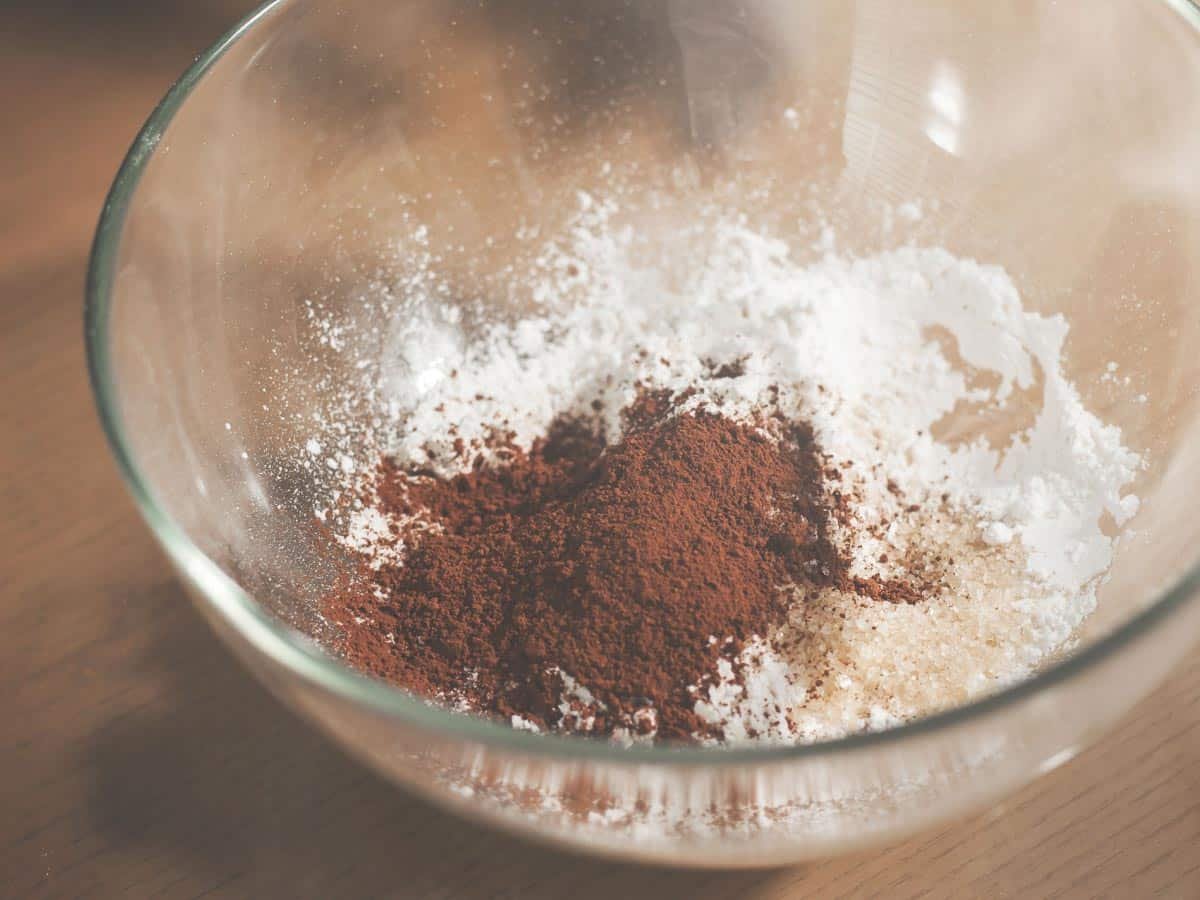
As stated before, hopefully the recipe you are using gives you clear ingredient recommendations. If it does not, and simply states “cocoa” or “unsweetened cocoa powder” then you have a bit of sleuthing to do.
Consider the context. If you are reading an older cookbook, say an American cookbook from the 1950s – like an early version of Joy of Cooking or Fannie Farmer, then chances are they want you to use natural cocoa. This is because that is what was available and widely used at that time. If you are cooking out of a mainstream magazine (not a cooking magazine) and a recipe lists “cocoa”, natural will probably be your best bet.
You can also look at the rest of the recipe. If it calls for baking soda only, use natural cocoa. If it lists baking powder only, then use Dutch-processed. Note that sometimes when Dutch-processed cocoa is combined with baking soda that a soapy flavor can develop. If the recipe lists both leaveners then all bets are off, as we cannot tell for sure.
But on the other hand, either might work. Truth be told, we have at times had as much success with one as with the other. It all depends on the specific recipe, however, always use what is recommended if it is specified.
If the recipe is not a baking recipe and is something like pudding, custard, hot fudge sauce, hot cocoa or similar, and no leaveners are present, then you have choices.
As explained before, Dutch-processed is darker in color and many people think it tastes richer and more “chocolatey”. Natural cocoa on the other hand is lighter in color and more astringent in flavor.
Fat Content of Cocoa
Since higher fat cocoa would be lower in carbohydrates and therefore most likely lower in FODMAPs, I thought it would be helpful to know the fat content of some popular cocoas. Here is a look at some brands and their fat content, per 1 U.S. tablespoon (as listed on their respective FDA labels). Terms below are as listed by manufacturer (alphabetical order); also, the brands have slightly variable gram weights per tablespoon and are listed as described by purveyor:
Fat Content Per Tablespoon
(6 g) Bensdorp Dutched Cocoa = 1.5 g fat
(15 g) Droste Cocoa Powder (Dutch-processed) = 2 g
(6 g) Ghirardelli Unsweetened Cocoa Powder (Natural) = 1.5 g fat
(6 g) Ghirardelli Unsweetened Dutch Process Cocoa = 1 g fat
(5 g) Guittard Rouge Cocoa Powder Unsweetened (Dutch-processed) = 1 g fat
(5 g) Hershey Naturally Unsweetened (Natural) = .5 g fat
(6 g) King Arthur Black Cocoa (Dutch-processed) = .5 g fat
(6 g) Navitas Organics Cacao Powder (Natural) = .6 g
(7 g) Penzey’s High Fat Cocoa (Dutch-processed) = 2 g
(5 g) Scharffen Berger Cocoa Powder (Natural) = 1 g
(9 g) Terrasoul Superfoods Raw Organic Cacao Powder (Natural) = .9 g
(7g) Valrhona Cocoa (Dutch-processed) – 1.5 g
(5 g) Viva Naturals Cacao Powder = .5 g
All of this means that we can eat all kinds of delicious favorites made with cocoa powder – from cookies, to brownies, waffles, hot cocoa and layer cakes!
Last Word on “Cacao”: It’s All About The Branding
As stated before, from the chocolate manufacturing industry’s perspective, there is no difference between cacao and cocoa powder. “Cacao” is a marketing term.
Let’s look at some facts:
- Many companies use the term “cacao” when they want their product to appear “healthier”.
- “Cacao” terminology is often used to describe organic and/or raw products in particular.
- The “raw” industry has no FDA guidelines, so we do not know what temperatures a “raw” product has been exposed to.
Personally, when I see the term “cacao” used to describe cocoa powder or a “raw” product I am immediately suspicious and instead of drawing me in, it has the opposite effect.
If you are in the U.S. you might associate cocoa powder with Hershey’s. They have been in business since 1894 and it has always been an easy-to-find supermarket brand, hence many Americans use Hershey’s cocoa as their standard pantry choice.
Hershey’s now does offer a Dutch-processed cocoa, which they call “Special Dark”, but they are known for their natural cocoa powder. Over the years the wording and the look of the can have changed.
On older cans they didn’t have to even detail what was in the can, as consumers understood, as seen below.
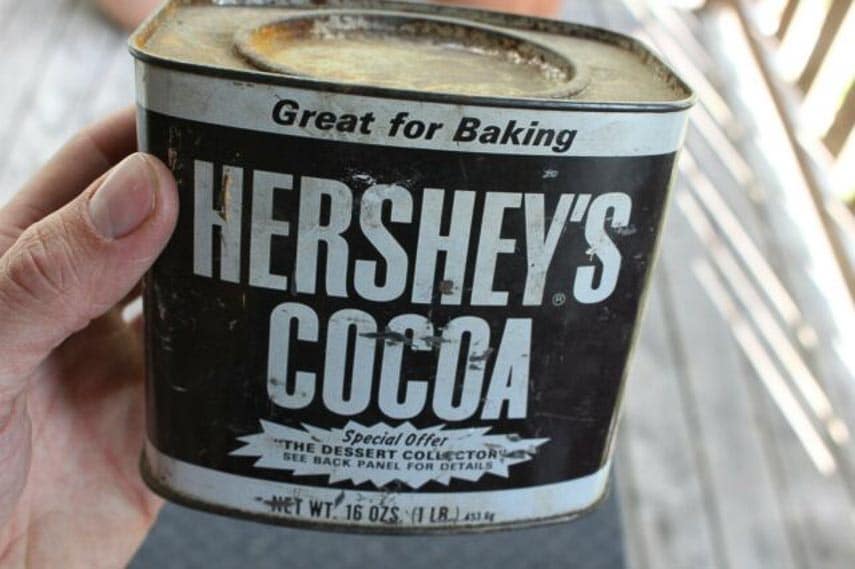
Then for many decades they added wording on the front, and detailed “100% cocoa”.
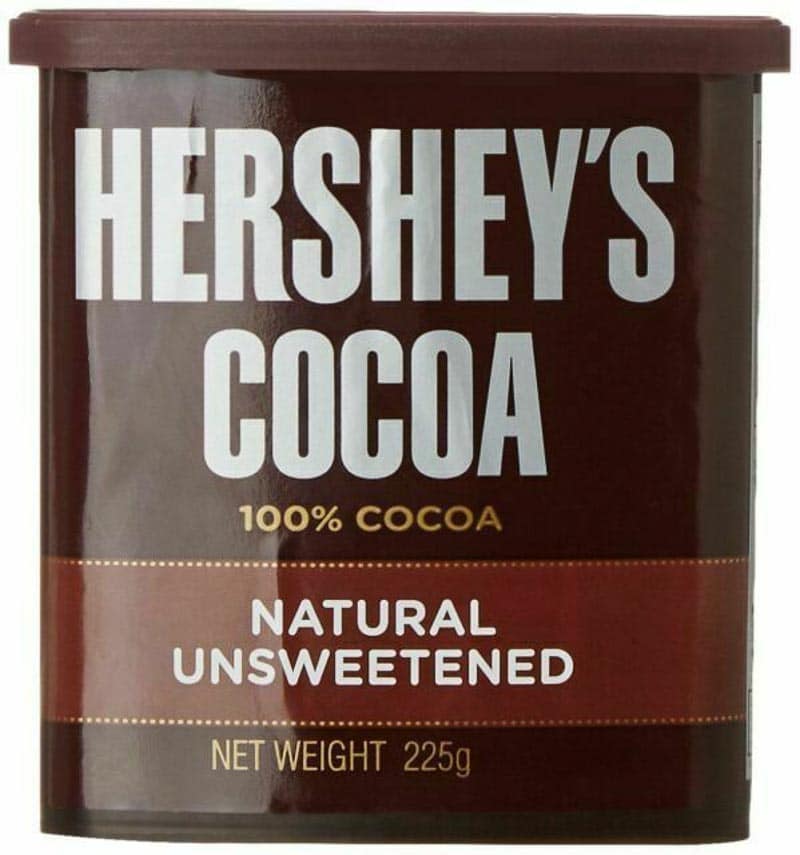
Recently they have changed the term to “cacao” on the front, because consumers think that is a better product and more “natural” (which has no meaning) …
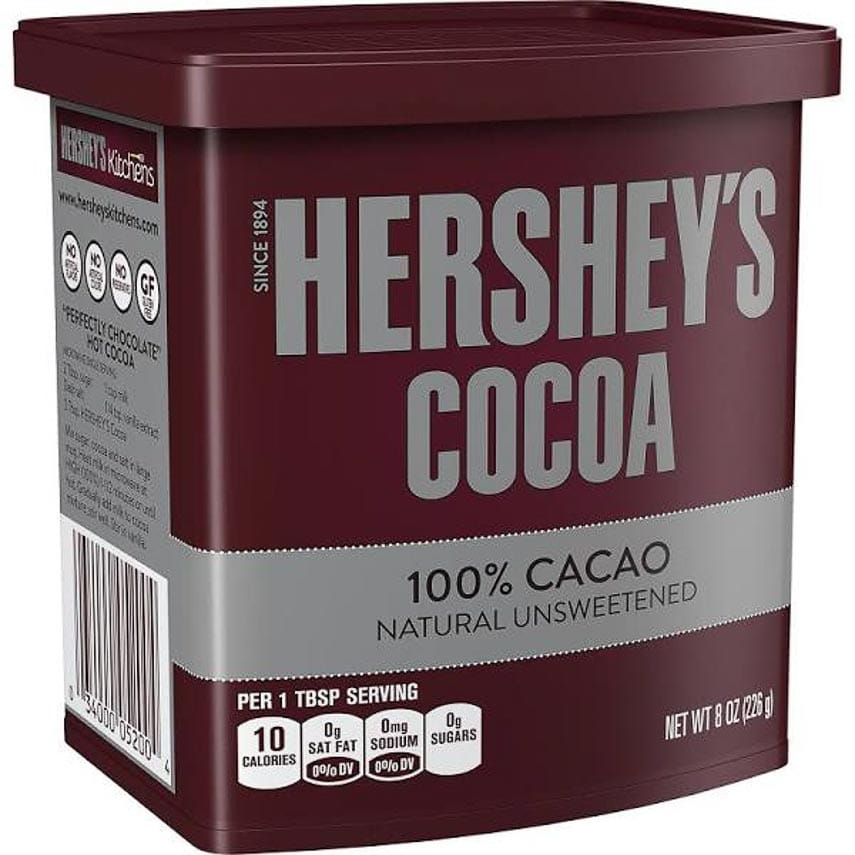
…but tellingly, the ingredient has always been listed as “cocoa” – even if it says “cacao” on the front. This is because the actual foodstuff is cocoa powder. The term “cacao” is just marketing.
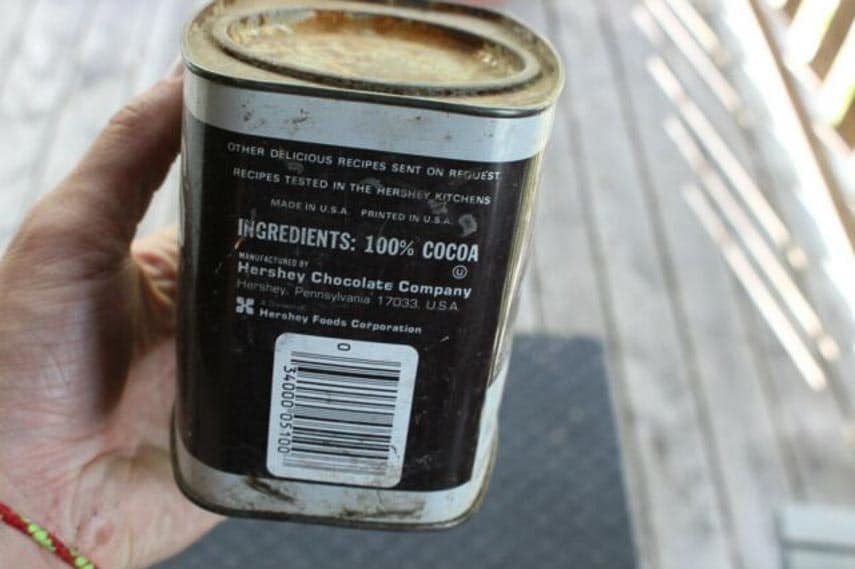
Low FODMAP Recipes Containing Cocoa
Now you know that you can have cocoa while following the low FODMAP diet, and even in amounts greater than 2 teaspoons (8 g) per serving. Of course, always eat to your tolerance. Here are just some of our favorite recipes using cocoa, including Hot Cocoa (which is not the same as Hot Chocolate, but we have that recipe, too).
- Chocolate Cupcakes
- Hot Cocoa
- Dark Chocolate Waffles
- Low FODMAP Gluten-Free Chocolate Pancakes
- Hot Fudge
- Chocolate Sorbet
- Double Chocolate Chip Peppermint Cookies
- Blackout Cake
- Pumpkin Layer Cake with Black Cocoa Frosting
- Mocha Toffee Crunch Cake (seen below)
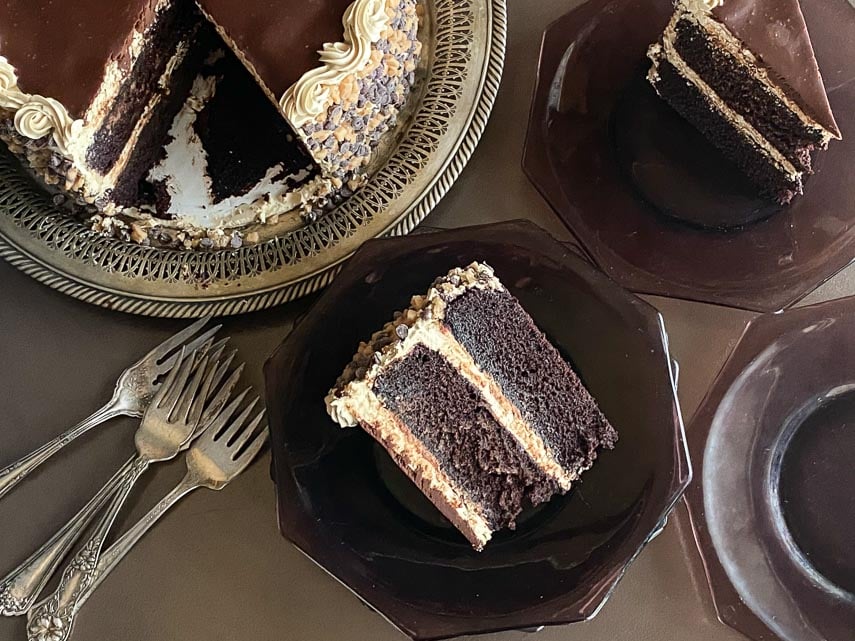
(Editor’s Note: I have been teaching classes on chocolate growing, harvest and manufacture for over 25 years to both food industry professionals as well as lay people, so I have a strong background in chocolate and pursue continuing education on a regular basis. We felt that this was important to note, since this article contains a fair amount of extrapolation and we want our readers to know that my statements come from a place of industry knowledge).
Here is an article that might also be of interest – The Truth About Raw Chocolate
Shop For Cocoa Here
-
Hershey’s Natural Unsweetened 100% Cocoa
-
Bensdorp 22/24 Fat Dutched Cocoa Powder from OliveNation$14.99
-
Barry Callebaut 70128 Semi Sweet Dark Chocolate Chips from OliveNation – 2 pound$29.98
-
Ghirardelli 60% Cacao Bittersweet Baking Chocolate Chips, 3 Pound
-
Guittard Fair Trade Akoma Extra Semisweet 55% Cacao Baking Chips$19.56
-
Guittard Chocolate Real Semisweet 46% Cacao Baking Chips$19.27






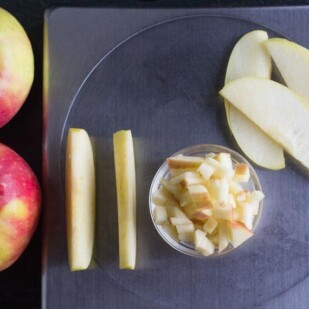
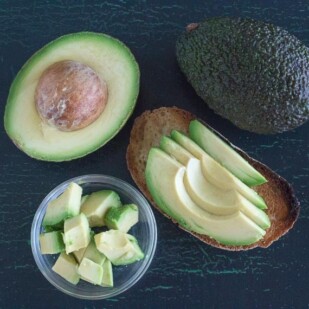






Excellent detailed article! Very helpful. Thanks
Thank you! We hope your baking with cocoa-full!
A very well-written, informative article. So glad I took the time to read this today.Truth be told I came on here because I was about to submit an online grocery order and Dutch processed is more expensive and I was wondering if I really needed to keep on using it in the recipes I cook for my son’s Low FODMAP treats. I have interchanged Natural for Dutch processed when I ran out of either. Now I understand “why”the taste difference.
SO glad you enjoyed it! We love all kinds of cocoa – and knowing the differences can make or break a recipe.
I was confused before, now im totally confused. Please add a clear exective summary at the beginning or end of this article.
The diet is very nuanced and complex and hardly anything about it is simple. How can I help you? Basically Monash is not aware of cocoa manufacture or terminology, and I have had conversations with them about this. Their app entries are what are confusing. As a consumer what you can do is approach it conservatively or more expansively. I choose the later. I personally can tolerate much more cocoa than what they have determined to be a conservative low FODMAP serving size, but your results might vary. Unless Monash tells us WHAT they tested – which they won’t – in terms of fat content of the cocoa tested, we truly cannot use their results to compare to what we buy.